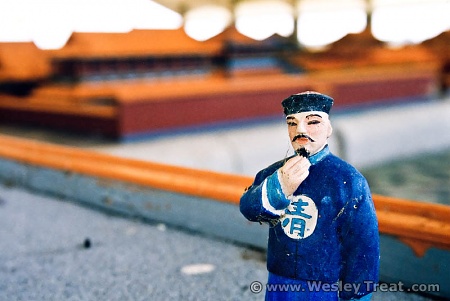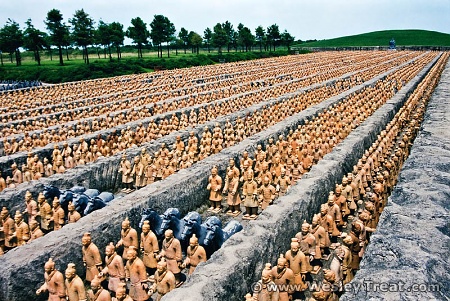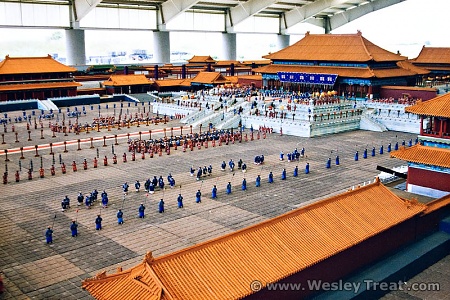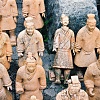When a free and sunny weekend makes its way into my schedule, I can't resist the urge to plant myself behind the wheel of my car, hastily prepared itinerary in hand, and head out along the great Texas highways in search of more of the unusual. Microcassette recorder tucked safely in my crotch (it slides around too much on the passenger seat), and camera packed securely in the back, I seek to increase my already bulging backlog of roadside attractions for the days when I feel I've had too much sleep and it's time to get up, brush my teeth and pass along another adventure.
One particular free and sunny weekend, I found myself at the mysterious Forbidden Gardens in Katy, Texas ... and today, I've brushed my teeth.
We'll start with a bit of history. In 1974, three highly significant events made their way into the record books. One, I was born. Two, the terra-cotta army of the first emperor of China was discovered. And three, Richard Nixon resigned his presidency. (Chronologically, it was the army, then me, then Nixon, but I was going by order of importance.)
We can get back to me and Nixon sometime later, but now I'll tell you a little more about that discovery in China.
To combat the effects of a winter drought that momentous year of 1974, farmers in eastern-central China worked to dig a well on the outskirts of Xi'an (pronounced SHEE-ahn). Unfortunately, they came up dry in the water department, but what they did unearth was far more valuable to both history and tourist revenue. They didn't know it at the time, but the bronze arrowheads and pieces of pottery the farmers were about to peddle in town were part of the legendary army of Emperor Qin.
Qin (pronounced chin) was the man who conquered the warring states that would be China and, well, united them into China. He is also the ruler credited with building much of the 2,000-mile-long Great Wall of China. (It's hard not to say "China" a lot here.)
Additionally, Qin constructed a magnificent tomb where he would be buried upon his death. (Unarguably the best time to be buried.) Although most records concerning the tomb have been lost or destroyed, it's believed that the body of Qin resides within Mount Li, along with valuable jewels, miniature cities and rivers of mercury, all guarded by a vast army of some 6,000 life-size, terra-cotta soldiers.
The tomb itself mostly remains a mystery, but the terra-cotta army, thanks to those thirsty farmers I mentioned earlier, have been uncovered and turned into a museum.
They've also been replicated in one-third scale on 80 acres of former rice land outside Houston. Six thousand soldiers stand ready over a stretch of land about the size of a football field. Rows upon rows of stoic defenders and their steeds wait to be called into action, lined up amid recreations of the archaeological site's dig walls.
It's a colossal and somewhat baffling panorama. And I couldn't help but think what a cool doorstop each and every one of those little warriors would make.
The attraction, a sort of historical Chinese theme park without rides, is the magnum opus of real-estate developer and reclusive millionaire Ira Poon. Poon, who reportedly splits his time between Seattle and Hong Kong, visits his pet project only once or twice a year. The employees at Forbidden Gardens say that even then he keeps to himself. He seems to keep the park to himself, as well, as he does little to promote the attraction. Hardly anyone knows it exists.
Those who do, which now include you, can enjoy not only the massive terra-cotta army, but also an expansive and intricate model of Beijing's Forbidden City. Shielded from the Texas sun by a 40,000-square-foot steel canopy, this highly detailed work was created at the insistence of Mr. Poon using authentic materials and traditional construction techniques. Along with its thousands of tiny residents, the display was carved, painted and assembled by hand.
Paths work their way through the model for the enjoyment of the normally statured, but one must take care when making use of them. Trudging amid the elaborate and life-like complex, you might find yourself in a Godzilla mindset, moments from cracking under the pressure of life as an enormous, misunderstood lizard and lashing out at the unsuspecting diminutives underfoot.
The attraction, suffering from the heat and humidity of the Gulf Coast, is showing its age, but efforts to keep the place in shape continue. There are also rumors that additions are on the drawing board.
Reportedly, Poon has planned a 60-foot observation pagoda and a lengthy model of the Great Wall of China. Someday, the park might also see a system of colored ponds, boat rides, a restaurant and a hotel. There are even rumors of a water park.
But in my opinion, the terra-cotta army is alone worth the trip. So, don't wait. Get out there and make sure this Lone Star wonder stays around for a long time.
And yes, I know, Godzilla was from Japan and not China, but there's nothing saying he couldn't vacation.







